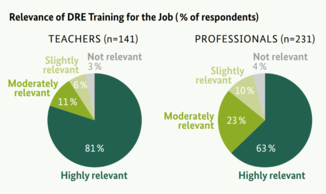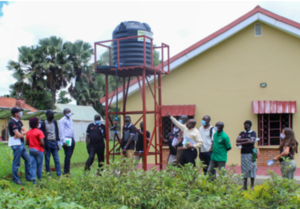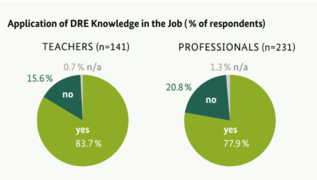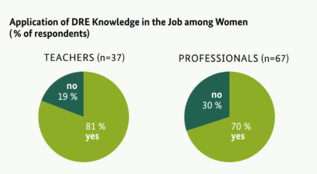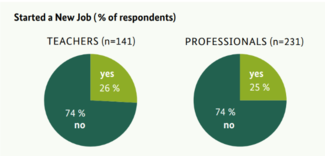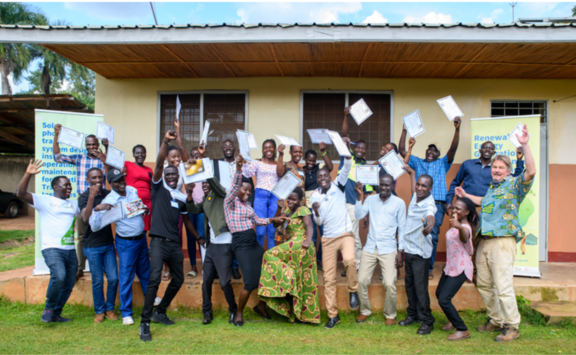Click here to register!
Difference between revisions of "Strengthening Solar PV Vocational Training and Promoting Energy Skills Development for Women in Uganda"
***** (***** | *****) |
***** (***** | *****) Tag: 2017 source edit |
||
| Line 52: | Line 52: | ||
In conclusion, the survey data in combination with training participants’ testimonies and the results of the qualitative interviews point to a positive impact of the project on the solar PV sector and the communities involved. Hence, it appears that the GBE intervention successfully addressed the issues of low rural electrification rates, low income, and the underdeveloped integration of women in the solar PV sector. | In conclusion, the survey data in combination with training participants’ testimonies and the results of the qualitative interviews point to a positive impact of the project on the solar PV sector and the communities involved. Hence, it appears that the GBE intervention successfully addressed the issues of low rural electrification rates, low income, and the underdeveloped integration of women in the solar PV sector. | ||
| − | ====Challenges==== | + | ====Challenges in Project Implementation==== |
While all interviewees considered the project a success, some challenges evolved during the course of the project implementation. In general, the biggest challenges are the training infrastructure and the skills to use it. The lack of necessary resources (e.g. equipment) in the respective institutions figured as the most important challenge among responding teachers in the survey. While this was addressed by installing demonstration systems in the three partner VTIs, other VTIs are often lacking funding to invest in technical training equipment. | While all interviewees considered the project a success, some challenges evolved during the course of the project implementation. In general, the biggest challenges are the training infrastructure and the skills to use it. The lack of necessary resources (e.g. equipment) in the respective institutions figured as the most important challenge among responding teachers in the survey. While this was addressed by installing demonstration systems in the three partner VTIs, other VTIs are often lacking funding to invest in technical training equipment. | ||
Latest revision as of 11:31, 21 March 2024
Strengthening Solar PV Vocational Training and Promoting Energy Skills Development for Women in Uganda
Project Approach
According to the latest available data from the Uganda Bureau of Statistics, the national average grid connection rate in Uganda was around 26 % as of 2019. However, the grid connection rate in rural areas, including northern Uganda, is generally lower than the national average with many households still relying on traditional energy sources such as biomass (e.g. firewood and charcoal). Hence, it is likely that in the coming years, the majority of Uganda‘s rural population will still be unable to obtain grid electricity and will therefore be dependent on alternatives such as clean off-grid renewable energy (RE) solutions. The potential for decentral RE solutions, particularly for solar energy, is high. In line with findings of the World Bank, Uganda possesses a solar energy potential of up to 200 gigawatt (GW), which is more than ten times the country‘s current installed capacity. Hence, the promotion of solar energy could also contribute to addressing the challenges of a weak economy and low incomes in Northern Uganda.The Ugandan government has recognised the potential of solar energy and has made efforts to promote its development, including support for off-grid solar projects in rural areas. Partly in cooperation with international donors, a number of mini-grids have been established - e.g. by the GIZ Pro Mini Grids Project.Despite endeavours in this regard, a skilled workforce to install new, operate, and maintain existing off-grid RE solutions is lacking in quantity and quality. What is more, women are underrepresented in the energy sector workforce, distinctively in technical and leadership roles. According to a report by the International Renewable Energy Agency (IRENA), women make up only about 20 % of the renewable energy workforce in sub-Saharan Africa. This is partly due to social and cultural factors that discourage women from pursuing careers in science, technology, engineering, and math (STEM) fields.
To address these problems and as a precondition for a more wide- spread usage of decentralised renewable energy (DRE) solutions, Green People’s Energy (Grüne Bürgerenergie, GBE) Uganda supports the expansion and quality improvement of DRE capacity building opportunities through its technical training and skills development component in the Northern Region of Uganda.
The component aims to develop and implement hands-on training programs on technologies relevant to the target group (e.g. solar-powered irrigation systems (SPIS)) to promote and develop the capacity of professionals in electricity and solar technology. To this end, the project collaborates with two vocational training institutions (VTI) and one higher education institution in Northern Uganda:
• the Daniel Comboni Vocational Institute (DCVI)
• the Comboni Technical School Angal (CTSA)
• the Gulu University (GU)
In cooperation with the Centre of Research in Energy and Energy Conservation (CREEC), Engineers without Borders - USA (EWB-USA), and the Renewables Academy (RENAC) the GBE project develops face-to-face and online training programmes (e.g. “Solar PV (photovoltaic) Training Course for VTI Instructors”) and materials, and conducts trainings as well as training of trainers (ToT). The target group for the trainings includes teachers and students in electrical engineering from different vocational schools in northern Uganda, as well as engineers and technicians from private solar companies, and agricultural and water engineers from district administrations. The renovation and equipping of solar training rooms, computer rooms and the establishment of demonstration gardens for SPIS constitute further project measures. Complementary to this, the development of a gender strategy and multiple activities to attract and to enable women to equally participate in the project’s capacity building measures, form part of the project portfolio.
Methodology of Data Collection
Data for this case study report was collected through a review of project documents, six qualitative interviews with representatives of GIZ, CTSA, DCVI, and Gulu University, a female participant of the ToT, and a female member of the Solar Irrigation and Agronomy Club at Gulu University as well as a quantitative survey among 180 teachers and 318 professionals. 141 of the teachers and 231 of the professionals participated in the survey. The case study was conducted between March and June 2023.
Key Findings
Project Achievements
The project successfully achieved its targets. A total of 180 teachers (including 39 women) participated in ToT and 318 professionals (including 88 women) were trained. Of these professionals RENAC alone trained 145, including 26 women, through a solar PV online training. Detailed in figure 1 below, in sum 91 % of teachers and 86 % of professionals underscore the relevance of the trainings for their jobs. Additionally, a modern solar training room was set up at the CTSA with practical teaching materials, such as solar training stands developed by the Cologne Chamber of Crafts (HWK). Three further demonstration centres for SPIS and horticulture (so-called demo gardens) were set up at DCVI, CTSA, and GU. The training institutions were supported in equipping computer rooms and purchasing professional software applications for designing and calculating solar systems. All of these measures have contributed to more practical trainings.For the VTIs the solar training rooms have also enhanced the training quality. For instance, one interviewee pointed out that the students now first receive a power point presentation in the classroom and then learn in practice how the theory is applied – for example, how direct current (DC) can be converted to alternating current (AC). This has led to a noteworthy increase in the students’ learning speed. Also, the teachers’ capacity has been enhanced and improved the quality of teaching, especially in combination with the new training manuals, the solar training stands, demo gardens, and the installed software to size solar systems and pumps. Another VTI representative stated that the GBE measures enabled the VTI to now implement the developed trainings themselves, ranging from one week to 6 months, depending on the category of participants – e.g. a five-week course conducted for the Associ- ation of SENDEA. Considering the empowerment of women in the energy sector, the proportion of female teachers trained was 21 % and of female professionals 28 %. Considerably more women than originally envisioned were reached due to a combination of different measures. For example, at CTSA in Northern Uganda a particular dormitory and washroom was built for female training participants allowing women to stay overnight. This was an important improvement directly targeting women’s needs, as before and in many other VTI, there are only male dormitories which exclude women from participating. Hence, this was a pull factor for women participation in rural areas, according to an interviewee. In addition, the trainings were advertised, and word-of-mouth recommendations of female training participants explicitly encouraged. During SPIS technical design trainings, private companies were encouraged to select two technicians of which one should be a female. Additionally, the project adapted the eligibility/qualification criteria to lower barriers of entrance for female participants. And because of the limited number of females in this technical field, the project widened its scope of potential target groups in order to maximise the few numbers of female professionals in the energy sector- these included solar technicians/engineers, WASH specialists, Agricultural engineers, etc. At DCVI, the GBE advisors established a provisional kindergarten for female participants allowing them to concentrate on the training content. With this measure, too, the needs of female training participants, often in charge of childcare, were considered and tackled.Another achievement was the establishment of the “Solar Irrigation and Agronomy Club” (the club) at GU, with a mandatory female representation of 70 % among its 30 members. The club aims to advance the use of renewable energy in crop production. As one interviewee remarked: “the club has many females in leading positions […] and all are given a platform to talk and to speak out.” Managed by the students, the club has established a demo garden with a green house, installed a solar-powered water pump, and raised water tanks on a redesigned tank stand with extra handrails and slanting non-steep staircases. This gender responsive and partly transformative measure of redesigning the tank stands has empowered women to easily access and fully manage the solar powered irrigation system. The tank stands are very considerate of the specific needs of women who had expressed reservations of climbing up the usually used ladders when wearing dresses.GBE designed and purchased a mobile training truck for SPIS to bridge the geographical gap between participants and the training centres. As a result, many women who could not travel to the VTIs were able to receive training within the vicinity of their home areas. This is yet another common structural burden for women to participate in trainings which has been addressed by the project.
All three partner institutions confirmed that they had incorpo- rated GBE’s gender mainstreaming approach with regard to the promotion of gender equality, the respect of women’s specific needs, the empowerment of women through education, the advancement of women’s roles in socio-economic positions. Hence, they unanimously considered the integration of women as one key element of the project. Lastly, several interviewees pointed out that it was crucial to persistently work to overcome the perception of RE being a justified male dominated area.
Intermediate Impact
The conducted trainings have improved the capacities of both target groups, i.e. teachers and professionals in the field of solar PV. 83.7 % of the surveyed teachers and 78 % of the surveyed professionals apply the newly gained knowledge in their job (see figure 2).
Specifically analysing female participants (teachers and professionals), 81 % of the female teachers apply their newly gained DRE knowledge at work. However, of the surveyed female professionals only 70 % compared to 78 % of all professionals apply the newly learnt content in their job. Among the 30 % women that do not apply the knowledge, a large majority stated as their current job either “student of RE technology” or “other” (see figure 3). Thus, these women either do not have a job (yet) to apply the knowledge in or work in other jobs (e.g. public institutions) were they cannot apply the knowledge but needed the capacitation as a background. Cultural norms and established stereotypes may also keep them from pursuing a profession in RE although they are qualified for it.
However, of the surveyed female professionals only 70 % compared to 78 % of all professionals apply the newly learnt content in their job. Among the 30 % women that do not apply the knowledge, a large majority stated as their current job either “student of RE technology” or “other” (see figure 3).
Thus, these women either do not have a job (yet) to apply the knowledge in or work in other jobs (e.g. public institutions) were they cannot apply the knowledge but needed the capacitation as a background. Cultural norms and established stereotypes may also keep them from pursuing a profession in RE although they are qualified for it.
At the level of training participants, among the numerous illustrating examples, one teacher explained that he provided “practical training in class, water pump installation at the institution, [and] client surface PV pump installation for dripping irrigation in Amuria [District]” based on the received capacity building. Another professional highlighted in detail: “I have been able to apply this knowledge in my job by recommending or designing solar-powered water pumping systems for communities that rely on traditional pumps fuelled by fossil fuels. Through these efforts, we have been able to not only reduce the cost of water pumping, but also decrease the carbon footprint of the communities. I have also been able to apply the knowledge gained from the training to evaluate the environmental impact of different energy systems used in my field.” Resulting from the above, the question arises: Have the capacity building measures translated into an improvement of the participants’ economic situation?A noteworthy majority of teachers (58 %) reports an improved professional performance, such as higher teaching quality, a stronger practice orientation of teaching or improved didactics. This leads to direct benefits for their employing institution and the students they train. Yet, only 35 % of female teachers come to the same conclusion. Of the 65 % (22) female teachers perceiving no increase in professional performance, an interesting 91 % however apply the newly gained knowledge and 82 % consider the training highly relevant. Moreover, 45 % of the teachers (41 % women) observe an increase in income. While the training measures were not designed as a job catalyst for teachers, a notable 26 % (27 % women) found a new job (see figure 5).Among the trained professionals an overwhelming majority of 91 % (90 % of the female professionals) record an improvement of their professional performance. Furthermore, 42 % overall and 36 % female professionals declare an increase in income.As one participant put it: “New skills and knowledge gained have improved my troubleshooting abilities and this has exposed me to many new clients and hence helping the community and as well additional income.” Considering that Northern Uganda is marked by a developing economy and the COVID-19 pandemic was ongoing during project implementation (see challenges), 25 % of the professionals (18 % women) started a new job after the trainings. One participant noted: “I had a training with RENAC, and this has made me get a job in a renewable energy company where I size systems and install them.” Another professional shared that he started a new job and “installed solar powered irrigation under [a] government project.”
At the institutional level, the interviewees of all three training institutions confirm that the newly created training modules now serve as an extra source of income by attracting students for trainings and that the inflow of funds is quicker in comparison to long courses. What is more, the established solar irrigation gardens have attracted interest from training institutions in other communities. CTSA, for example, often receives members of other institutes keen on learning how solar-powered irrigation and planting works. At GU, according to interview partners, the farmers in the community are now aware that GU is growing and selling seedlings. Common farmers mostly do not have the means to set up a greenhouse to grow them and find it a lot easier to buy seedlings instead of seeds that need much more attention. Buying seedlings, thus, increases their productivity and has led GU to sell more than 10,000 seedlings in 2022. At DCVI, the vegetables grown are used to supplement student meals, thereby reducing the catering costs. CTSA, reported that they are selling the tomatoes to the community, earning extra money. The VTI thereby attracts vulnerable youth, who come to learn how to grow vegetables themselves, a “huge success” in the words of one interviewee.
In conclusion, the survey data in combination with training participants’ testimonies and the results of the qualitative interviews point to a positive impact of the project on the solar PV sector and the communities involved. Hence, it appears that the GBE intervention successfully addressed the issues of low rural electrification rates, low income, and the underdeveloped integration of women in the solar PV sector.
Challenges in Project Implementation
While all interviewees considered the project a success, some challenges evolved during the course of the project implementation. In general, the biggest challenges are the training infrastructure and the skills to use it. The lack of necessary resources (e.g. equipment) in the respective institutions figured as the most important challenge among responding teachers in the survey. While this was addressed by installing demonstration systems in the three partner VTIs, other VTIs are often lacking funding to invest in technical training equipment.
Another overarching challenge is gender equality in the country. According to an interviewee this “starts in childhood of women with the mindset that RE is for males and women are supposed to do arts and humanities. It is a long road to change mind sets. It should start at primary schools with, for example, role models telling girls that science is not only for males. But this takes time.” Another interviewee of the SPIS club added to this point that “men sometimes come in with their biases (in meetings, events, or the like) and then they are sometimes jealous or want to take control. It was challenging for them in the beginning.” Also challenging for an institution was a financial aspect. According to an interviewee, when “the planting process does not go well, crops sometimes need plant protection products and those quickly.” But “GIZ procurement procedures are comprehensive and lengthy. [Also] at some time a solar pump was defective and due to procurement procedures, it took a long time to repair it which damaged the crops.”
The COVID-19 pandemic and its aftermath posed another major challenge to the project and negatively influenced the teachers (70 %) and professionals (63 %), including the world’s longest school lockdown for almost two years between 2020 and 2022. Many of the surveyed participants lost their jobs during the pandemic and one training participant summarized the situation as follows: “Many people are now poor as a result of COVID-19 so they cannot afford to install the irrigation systems in their farms, so there were less practical [opportunities] to enhance the profession.” The supply side of better qualified professionals, also needs a demand side of clients able to purchase DRE solutions and ser- vices in low income, rural areas. Hence, it is plausible to assume that the pandemic constraint further increases in income and the finding of more jobs for the target group. Similarly, an interviewee from another VTI described that the project intervention came during the COVID-19 pandemic. Not enough students were in school and, consequently, school fees were low at that time. The VTI then received materials to build new infrastructure from the GBE project, but had no funds to pay the construction workers.
Lessons Learned
The challenges of insufficient infrastructure and skills development have been comprehensively addressed by the project mea- sures and gave rise to the training component in the first place. During the implementation process, it also became apparent that soft skills play a significant role for professional development. As one interviewee underscored the point and elaborated: “We learned how to relate with others, we learned teamwork (every day in a different group) and we learned time management.” With regard to the improved infrastructure, another interviewee pointed out: “previously we had to transport students far away, now we have the facilities within our premises, which is much easier.” Regarding the above mentioned sometimes lengthy GIZ procurement procedures, it could be conducive to have a form of emergency fund or proportion of the local subsidy position reserved for quick responses in future projects – e.g. to be able to act before the crops shrivel. Building sustainability of VTIs from the start of the project is also crucial so that institutions are able to trouble shoot and resolve operations and maintenance challenges while they await for added support from development partners. For example, invest savings and earnings from the demo gardens into repairs.A key success factor for female participation in the project measures, was to move beyond complying with quotas envisioned for the country measure. Of course, the project fulfilled its gender sensitive duties, advertised and raised awareness (e.g. “Gender-smart Awareness Workshops”) to reach the target numbers but more importantly also ensured that the women truly benefitted from the measures and partly facilitated transformative change. However, the stakeholders involved recognised that, according to one interviewee, the “food energy and water nexus is dominated by men” and that it was necessary to engender the technical field of solar PV by empowering women to become leaders in the field of productive use of energy (e.g. in the club). Based on GBE’s gender strategy, the implementers also developed gender responsive measures, like building the women dormitory and washing room as well as establishing a provisional kindergarten to ensure that women could benefit from project activities. They also facilitated peer-to-peer learning among women students.On a very practical level, gender mixed teams for the design of solar appliances should be considered to bring in the women’s perspective and include women’s needs. For example, sometimes the batteries and solar panels are too big to handle for women or opening a valve is sometimes too hard and the lock mechanism could be designed differently. Despite all these efforts, the interviewees also acknowledged that it is a long way to go to truly change power relations between men and women in the society, change gender norms, and to enhance women’s decision-making power. Thus, another interviewee concluded that “a national level effort is needed to unlock the full potential of women” and to transform society with regard to equality. From a project management point of view, the clearly defined memoranda of understanding (MoU) between GBE and the partner institutions were mentioned as a prerequisite for success. To manage expectations, define responsibilities and to provide planning security, the MoUs were indispensable. Based on the MoUs, transparent communication with all stakeholders, dispersion of information into the teams, and regular feedback were further conducive factors.
Sustainability of the Intervention
The project measures have a long-term impact on the partner educational institutions because they have all integrated the developed courses and developed training materials into their educational offerings. At DCVI, the solar PV course can now be taken in the curriculum instead of merely being a unit. The Directorate of Industrial Training (DIT) approved and accepted the training manuals and the DCVI is now implementing certified curricula, including the developed trainings. At GU, the training courses have been accommodated in the B.Sc. programme “Principals and Practices of Irrigation” and the M.Sc. “Irrigation Drainage Design and Management.” Lastly, CTSA reports being in the process of registering the developed trainings with the DIT. Registration and certification are the key to long-term provision and demand for the courses. A survey testimony underscores this point, stating: “Solar is everywhere in the village now, but we need certified technicians.”
The developed training courses are also a means of extra income for the training institutes, thereby supporting their sustainability because they enable them to reinvest, e.g. to replace the batteries. Additionally, CTSA reports that planting crops (tomatoes, eggplants, and onions) with the new SPIS now three times a year in the demo garden and subsequently selling them on the market yields a noteworthy extra income. Next to growing vegetables instead of buying them for students, DCVI has set up a sustain- ability plan with GBE Uganda and provides its computer lab on weekends to externals to gain an extra income. Lastly, the club at GU sells seedlings and vegetables at an already considerable scale (see intermediate impacts) and also serves with its high female membership rate as a role model for future female students. The capacity building itself also has a sustainable impact because both targets groups apply the gained knowledge in their professions, with roughly 84 % teachers and 78 % professionals (see figure 3). Next to the mentioned certification of the courses, the training materials were also developed to facilitate the long-term use of the contents. 79 % of the teachers confirm the receipt of the training materials and thereof 95 % use the materials. Among the professionals, in turn, 76 % have received the training materials and 92 % of them make use of them.
Conclusion and Outlook
The seven different trainings in the fields of solar PV and SPIS were developed successfully, and the respective training materials developed. More than 90 % of the teachers consider the trainings either highly (> 80 %) or moderately relevant for their profession. Among the professionals 63 % consider the trainings highly relevant, 23 % moderately relevant, and 10 % slightly relevant. As one participant illustrated that due to the training he “procured and installed a 3kw solar PV systems at a nurse training institute in northern Uganda.” Hence, the capacity building measures were tailored to the needs of the target groups.The capacity building measures have led to several lasting impacts. Through further qualified teachers and professionals the project contributes to the improvement of the solar PV sector and the communities it intervenes in, tackling the issues of low electrification rates, low income and a weak economy in rural Northern Uganda.
Moreover, the demonstration gardens have contributed to the self-sustainability of the training institutions and at the same time disseminated the knowledge about solar-powered irrigation and improved vegetable cultivation in their communities. The three training institutions attract the interest of other VTIs willing to tap the knowledge and potential of DRE solutions with certified courses. Adding to this, an interviewee from one institution highlighted: “we are now a pilot, a demonstration project that others come to see and learn from us.” This observation holds equally true for the measures applied supporting the empowerment of women in the energy sector. The infrastructure built to serve the needs of women, will have a lasting effect for future cohorts of training participants. Next to the anchored gender mainstreaming approach in the institutions, the trained female participants and the female members of the Solar Irrigation and Agronomy Club serve as role models in their communities for other women to follow their example. Particularly the capacitated female trainers may also empower other women at their institutes. This is particularly important, as it remains a challenge to attract women to STEM professions.Since the infrastructure is already available at the three partner institutions, one avenue would be to vertically scale up the project. Additional, more specialized courses requiring a higher level of qualification could be offered. Lastly, the lowest hanging fruit would be to horizontally scale up the project concept in different regions and/or at different vocational training institutes. The project design and described results offer the potential to achieve lasting impacts at comparatively low costs.

